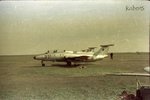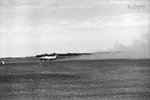Admittedly if you have put nimonic hot end components in you have improved the Schwalbe considerably (the Americans did that, of necessity). 
Then, there are all the other myriad of problems such as
- bad design rigour in terms of the undercarriage - liable to catastrophic failure If not the undercarriage, then watch our for the wings failing catastrophically
If not the undercarriage, then watch our for the wings failing catastrophically
- poor rough field capability leading to inflexible deployment and susceptibility to allied targeting of concrete airstrips
- likelihood of flameouts due to surge
- very poor thrust to weight ratio (around half)
- poor thermal efficiency (around 20% difference)
- poor braking
- lack of air brakes
- poor integrity of construction - admittedly, this may be because they were using slave labour, but that was their problem - it fell to bits - they werent even game to do a roll in it!
- the axial flow engine was more susceptible to damage by gunfire, both because of its relatively large size (much longer) and being more flimsily built
Apart from that it was not all that bad, really.
Then, there are all the other myriad of problems such as
- bad design rigour in terms of the undercarriage - liable to catastrophic failure
- poor rough field capability leading to inflexible deployment and susceptibility to allied targeting of concrete airstrips
- likelihood of flameouts due to surge
- very poor thrust to weight ratio (around half)
- poor thermal efficiency (around 20% difference)
- poor braking
- lack of air brakes
- poor integrity of construction - admittedly, this may be because they were using slave labour, but that was their problem - it fell to bits - they werent even game to do a roll in it!
- the axial flow engine was more susceptible to damage by gunfire, both because of its relatively large size (much longer) and being more flimsily built
Apart from that it was not all that bad, really.


